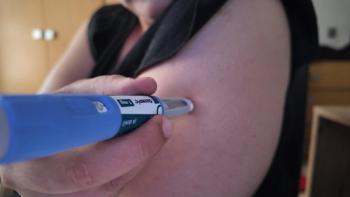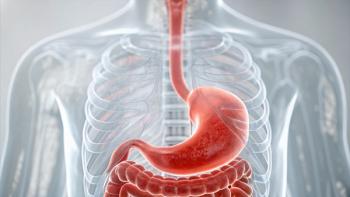
Atezolizumab Signals OS Improvement in Patients with Resected NSCLC
Phase 3 findings from the IMpower010 trial show that patients with resected non–small cell lung cancer may achieve an overall survival benefit with atezolizumab.
A trend in overall survival (OS) improvement was observed among patients with resected non–small cell lung cancer (NSCLC) who were treated with atezolizumab (Tecentriq) vs best supportive care, according to phase 3 findings from the IMpower010 trial (NCT02486718).1
A presentation at the
In all patients who were randomized to treatment, the median OS was not reached in the atezolizumab (n = 442) and best supportive care groups (n = 440; HR, 0.95; 95% CI, 0.74-1.24), respectively. OS events occurred in 26.0% and 26.4% of patients in each respective group. In the intent-to-treat (ITT) population, the median OS was also not reached in either the atezolizumab (n = 507) or best supportive care (n = 498) cohorts (HR, 0.995; 95% CI, 0.78-1.28; P = .9661). OS events were reported in 25.0% and 24.9% of patients in each group, respectively.
Further, the investigators conducted a subgroup analysis in patients with PD-L1–positive stage II/IIIA disease.
“We performed the subgroup analysis of OS…there is a trend towards an improvement in [OS] for those patients receiving atezolizumab,” according to lead author Enriqueta Felip, MD, PhD, head of the lung cancer unit, Department of Oncology at Vall d’Hebron University Hospital. “We can see that for those patients with squamous cell carcinoma, the hazard ratio for OS was 0.85; for those patients with nonsquamous cell, it was 0.61; for those patients with pathological stage IIA [disease], the HR was 0.75; for [those with] stage IIB [disease, the HR was] 0.64; and [for] stage IIIA [disease], it was 0.70.”
The study included patients with stage IB to IIIA tumors that were 4 cm or greater who had an ECOG performance status of 0 or 1. Patients also needed to have undergone a lobectomy and have tumor tissue available for PD-L1 analysis.
Patients (n = 1280) initially received treatment with cisplatin and pemetrexed, gemcitabine, docetaxel, or vinorelbine for 1 to 4 cycles of treatment and were then randomized 1:1 (n = 1005) to either the experimental or control group. Patients in the experimental group were then treated with 1200 mg of atezolizumab every 21 days for 16 cycles or 1 year, and the placebo group received best supportive care. Patients were stratified based on sex, stage, histology, and PD-L1 status.
The primary end point was investigator-assessed disease-free survival (DFS) tested hierarchically, with secondary end points including OS in the ITT population, DFS in the PD-L1 population, and 3- and 5-year DFS. OS biomarker analyses were also performed as part of an experimental end point.
A previous readout from an interim analysis indicated that at a median follow up of 32.0 months,2 the OS data were not mature, with investigators citing an event-to-patient ratio of 19% in the ITT population and 18% in the best supportive care arm. The hazard ratios (HR) were 0.77 (95% CI, 0.51-1.17) in those with PD-L1 expression of 1% or more, 0.99 (95% CI, 0.73-1.33)
in all randomized patients, and 1.07 (95% CI, 0.80-1.42) in the ITT population.
Moreover, HRs for DFS were 0.66 (95% CI, 0.50-0.88; P = .0039) for the PD-L1 expression of 1% or more population, 0.79 (95% CI, 0.64-0.96; P = .0205) in the overall randomized population, and 0.81 (95% CI, 0.67-0.99; P =.0395) in the ITT population.
Additional findings from the study indicated that the OS rates at 36 months and 60 months among those with a PD-L1 expression of 50% of more who were treated with atezolizumab were 89.1% and 84.8%, respectively, vs 77.5% and 67.5% in the best supportive care arm. Median OS was not reached in either arm (HR, 0.42; 95% CI, 0.23-0.78).
Any-grade adverse events (AEs) were reported in 92.5% of patients in the atezolizumab arm and 70.9% in the best supportive care arm, of which 67.9% and 0.0%, respectively, were treatment related. Moreover, 22.0% and 11.5% of AEs in either arm were grade 3/4, 10.7% and 0.0% of which were treatment related. Investigators also reported that 7.5% of patients in the atezolizumab arm and 0.0% of those in the best supportive care arm experienced serious treatment-related AEs, and 1.8% and 0.6% had grade 5 AEs, respectively. Additionally, 28.7% and 18.2% of patients in the atezolizumab arm required a dose interruption or treatment withdrawal due to AEs vs no patients in the control group.
Felip concluded by stating the trial will be continuing to the final DFS and OS analysis.
References
- Felip E, Altorki N, Vallieres E, et al. IMpower010: overall survival interim analysis of a phase III study of atezolizumab vs best supportive care in resected NSCLC. Presented at the 2022 World Conference on Lung Cancer; August 6-9, 2022; Vienna, Austria; PL03.09.
- Felip E, Altorki N, Zhou C, et al. Adjuvant atezolizumab after adjuvant chemotherapy in resected stage IB–IIIA non-small-cell lung cancer (IMpower010): a randomised, multicentre, open-label, phase 3 trial. 2021;398(10308):1344-1357. doi:10.1016/S0140-6736(21)02098-5
Newsletter
Knowledge is power. Don’t miss the most recent breakthroughs in cancer care.






























































































